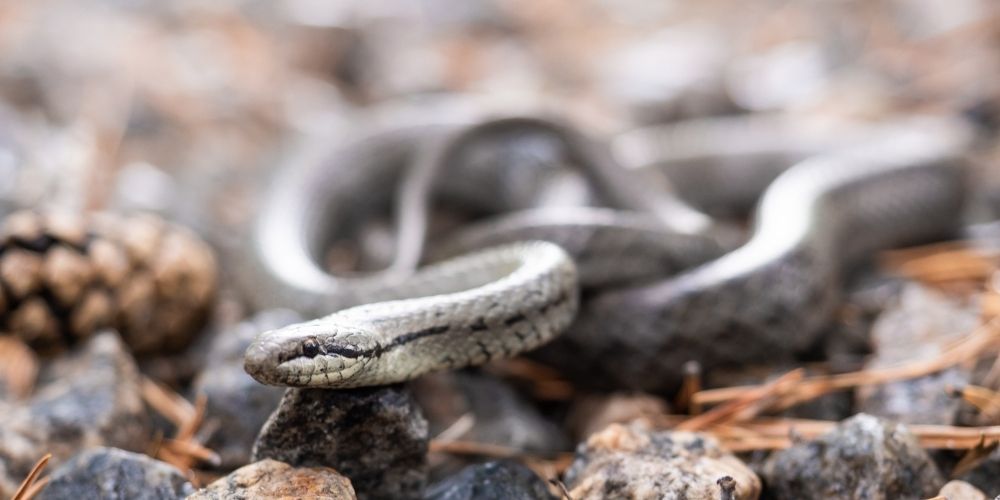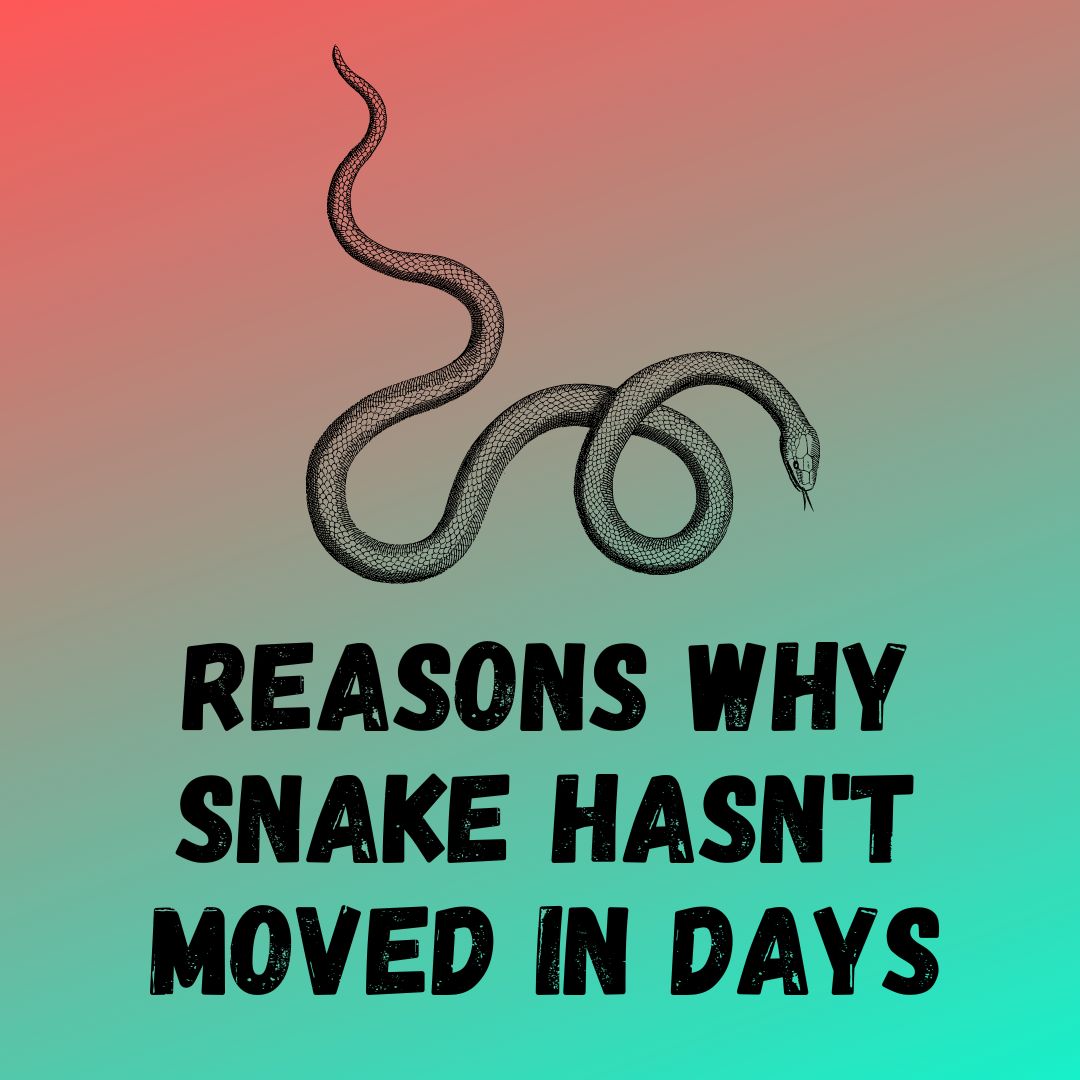There could be several reasons why a snake hasn’t moved in days, some of which may be related to its natural behavior, while others may indicate an underlying health issue. Here are a few possible reasons:
- Shedding: Snakes usually become inactive and rest more during the shedding process, which can take several days.
- Brumation: Brumation is a type of hibernation for reptiles, and some species of snakes may become less active or stop moving during this period.
- Digestion: After eating a large meal, snakes may become inactive and rest while they digest their food.
- Illness or injury: If a snake is sick or injured, it may not have the energy to move around as much as it normally would.
- Stress: Snakes can become stressed by changes in their environment or handling, which may cause them to become less active.
- Age: Older snakes may become less active and move around less frequently than younger snakes.
- Ambient temperature: If the temperature in the snake’s enclosure is too low, it may become sluggish and inactive.
- Lack of stimulation: Snakes in captivity may become bored or lack stimulation, which can cause them to become less active.
- Pregnancy: Female snakes that are pregnant may become less active as they prepare to lay eggs.
- Natural behavior: Some species of snakes are naturally less active and may spend more time resting than others.
It’s important to monitor the snake’s behavior closely and seek veterinary care if there are any concerns about their health. A veterinarian who specializes in reptiles can help determine the cause of the snake’s inactivity and provide appropriate treatment if needed.

Post Contents
10 Reasons Why Your Snake Isn’t Active
Here are ten possible reasons why your snake isn’t active:
- Temperature: Snakes are ectothermic, which means that their body temperature is regulated by the environment. If the temperature in their enclosure is too low, they may become lethargic and less active.
- Lighting: Snakes require a day/night cycle and appropriate lighting. If the lighting is not adequate or the photoperiod is not set correctly, they may not be active during the day.
- Feeding: If your snake is not eating regularly or is not receiving a balanced diet, it may not have enough energy to be active.
- Digestion: After a meal, snakes may become less active and hide away while they digest their food. This is a normal behavior.
- Shedding: Snakes may also become less active and hide away when they are shedding their skin. This process can take several days, and during this time, they may not move around as much as usual.
- Brumation: Some species of snakes go through a period of inactivity known as brumation during the winter months. During this time, they may appear lethargic and not move around much.
- Illness or injury: If a snake is not moving for an extended period and seems unresponsive, it may indicate an underlying health issue. Some common health issues in snakes include respiratory infections, parasitic infections, or injuries.
- Stress: If the snake’s environment is not suitable or they are exposed to stressors such as noise or handling, they may become less active.
- Age: Older snakes may not be as active as younger ones, and their activity levels may decrease as they age.
- Personality: Like people, snakes have their own unique personalities, and some may simply be less active than others.
Snake Brumation Explained
Brumation is a period of inactivity that some species of snakes and other reptiles go through during the winter months. This period is similar to hibernation in mammals, but it is not the same thing.
During brumation, the snake’s metabolic rate slows down, and its body temperature drops. They become less active and may not eat for several weeks or even months. This behavior helps them conserve energy during the colder months when food is scarce.
The exact timing and duration of brumation vary depending on the species of snake and the local climate. In general, snakes that live in cooler regions with distinct seasons are more likely to undergo brumation than those that live in warmer regions.
It’s important to note that not all species of snakes go through brumation. Some tropical species may continue to be active year-round. Additionally, the decision to brumate is not entirely up to the snake. Environmental factors such as temperature and day length can trigger brumation, and some captive snakes may not brumate at all if their environment remains warm and bright throughout the year.
If you have a pet snake that normally undergoes brumation in the wild, it’s important to replicate this natural process in captivity. This involves gradually decreasing the temperature in the enclosure and reducing the photoperiod (the amount of time the lights are on each day) to simulate the shorter days of winter. It’s important to do this gradually and under the guidance of a veterinarian who specializes in reptiles to avoid stressing or harming the snake.
It’s important to note that snakes have different behavior patterns, and some species may exhibit different behaviors than others. However, here are some possible explanations for the behaviors you described:
More FAQ’S Related to Snake Inactivity
- Snake not moving: A snake that is not moving could be sleeping, resting, or hiding. It’s also possible that the snake is sick or injured, in which case it may be less active than usual. However, if you are concerned that the snake may be dead, gently touch it with a long object, such as a snake hook, to see if it responds.
- Snake not moving after eating: After eating, snakes may become less active as they focus their energy on digesting their meal. This is normal behavior, and it’s best to avoid handling or disturbing the snake during this time.
- Snake not trying to escape: If a snake is not trying to escape from its enclosure, it may be because it is content and feels safe in its environment. However, it’s important to make sure that the enclosure is secure and that the snake has access to appropriate hiding spots, water, and food.
- Snake going to the top of the tank: Snakes may go to the top of their enclosure for several reasons, such as to regulate their body temperature or to explore their surroundings. However, if the snake is spending a lot of time at the top of the tank and seems agitated or stressed, it may indicate an issue with the enclosure or the snake’s environment.
- Snake burrowing in its aspen and not moving: Snakes may burrow in their substrate for several reasons, such as to regulate their body temperature or to hide from predators. However, if the snake is not moving at all and seems unresponsive, it may indicate an underlying health issue, and it’s best to seek veterinary care.
How Do I Know if My Snake Is Dying? Common Signs
It can be difficult to tell if a snake is dying, but here are some common signs that may indicate a problem:
- Lethargy: A snake that is not moving or is moving very little may be lethargic, which could be a sign of illness or injury.
- Lack of appetite: If a snake stops eating or shows a decrease in appetite, it could be a sign of an underlying health issue.
- Weight loss: If a snake is losing weight, it could be a sign of an underlying health issue, especially if it is not eating.
- Respiratory issues: If a snake is having difficulty breathing, is wheezing, or has discharge coming from its nose or mouth, it could be a sign of a respiratory infection or other issue.
- Abnormal shedding: If a snake’s skin does not shed properly, it could be a sign of an underlying health issue.
- Behavioral changes: If a snake’s behavior changes suddenly, such as becoming more aggressive or hiding more than usual, it could be a sign of an underlying health issue.
- Changes in color or appearance: If a snake’s skin color or texture changes, it could be a sign of an underlying health issue.
If you notice any of these signs, it’s important to seek veterinary care as soon as possible. Prompt treatment can increase the chances of a successful outcome.
Summary
It’s important to monitor your snake’s behavior closely and seek veterinary care if you have concerns about their health. A veterinarian who specializes in reptiles can help determine the cause of the snake’s inactivity and provide appropriate treatment if needed.

94% of pet owners say their animal pal makes them smile more than once a day. In 2007, I realized that I was made for saving Animals. My father is a Vet, and I think every pet deserves one. I started this blog, “InPetCare”, in 2019 with my father to enlighten a wider audience.
